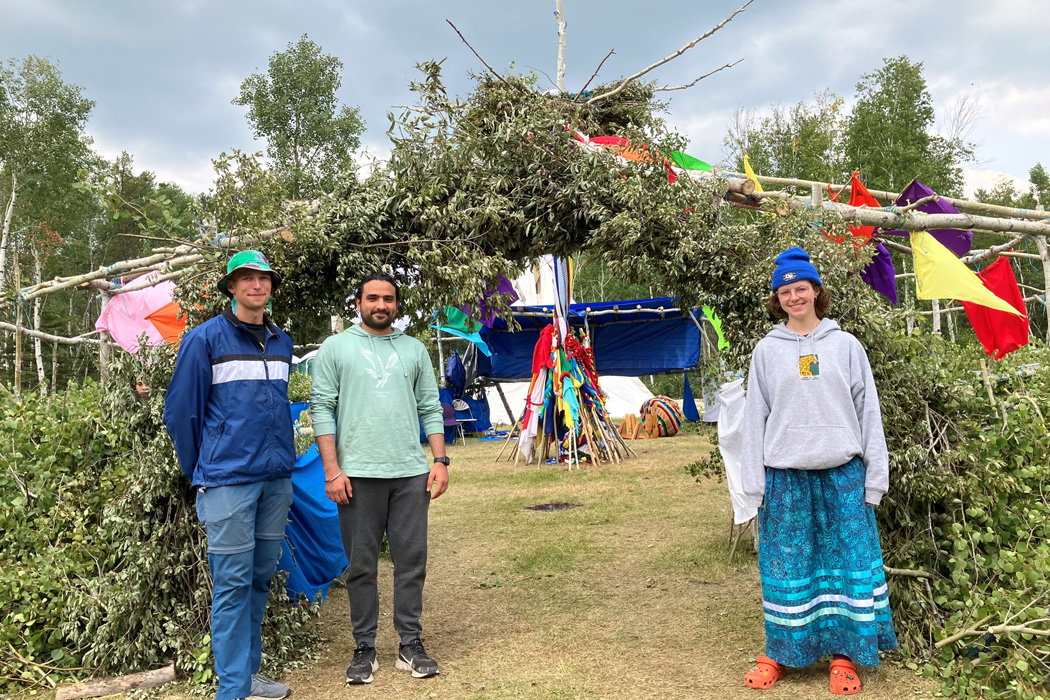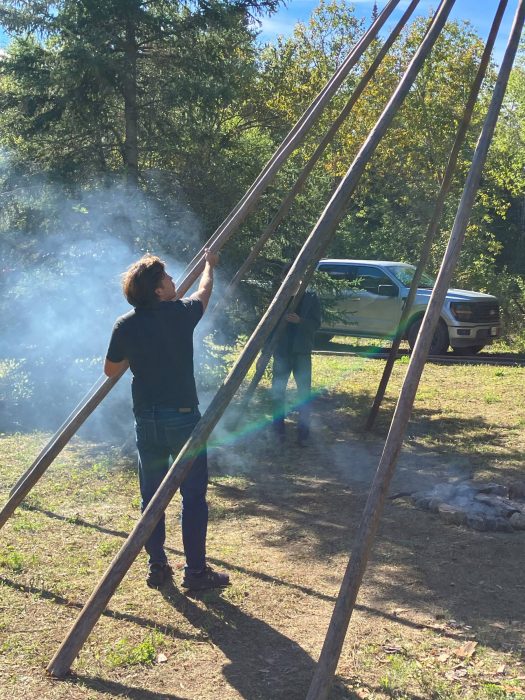
(L-R) Recent College of Nursing graduates Jordan Braun and Karanpreet Singh with Max Rady College of Medicine student Maura Macauly at the Shallow Bay sundance lodge near Grand Rapids.
Sundances offer students ‘crash course in culture’
A program through the Office of Interprofessional Collaboration (OIPC) at the Rady Faculty of Health Sciences is helping students connect with Indigenous communities through ceremony.
The program, which is supported by the RBC Experiential Learning Travel Initiative, was given the name ‘Ndinawemaaganag’ – Anishinaabemowin for ‘all my relations’ – by Elder Margaret Lavallee, of Ongomiizwin – Indigenous Institute of Health and Healing, to reflect the connections the students were making with each other, the land and the community.
It began in 2017 as a two-week experience for interprofessional students to work together in First Nation health centres and nursing stations. Over the last few years, the program has evolved to include students helping at sundance ceremonies in four communities.
“In 2019, the health director in Misipawistik Cree Nation near Grand Rapids suggested the students be helpers at one of their sundances. She suggested attending a land-based ceremony would be a powerful way for us to learn about community, health and ways of healing,” said Lisa Mendez, collaborative health care practice lead with OIPC.
A sundance is a sacred ceremony that, while once outlawed in Canada, has made a resurgence in many Indigenous communities. George Muswaggon, Knowledge Keeper at Ongomiizwin, said that each community’s sundance is unique, although they all share core values of spirituality, community and nature.
For these specific sundances, an eight-sided lodge is erected where a four-day ceremony is held. The size of the lodge varies, depending on the needs of the community. Sweat lodges are also built for participants to use prior to the ceremony.
Muswaggon described the sundance and related activities as a “crash course in culture” and said students assist with anything that is needed, including the building of the lodges.
“It’s one of the best cross-cultural trainings that you can provide future health professionals. The building of the lodge – also known as ‘tree day’ – is labour-intensive. It is a marathon day that is hands-on and has all the elements – mosquitos, terrain, sun, rain,” he said. “But you can see the students’ desire to learn. The transformation observed has time and again demonstrated that learning opportunities like these should continue to be supported and expanded.”

Dustin Erickson at Misipawistik Cree Nation.
Since the program’s inception, 48 learners from eight Rady programs have helped in 10 ceremonies. This year, students from nursing, midwifery, pharmacy, physical therapy, occupational therapy, respiratory therapy and medicine took part in four sundances in Spruce Woods, Misipawistik Cree Nation, Opaskwayak Cree Nation and Pimicikamak Cree Nation.
Dana Riseling, a second-year occupational therapy student from the College of Rehabilitation Sciences, was involved in two sundances this summer. She helped with building the lodge and assisted with smudging.
“It’s a very intimate space and it was humbling and an honour to be able to participate in that way,” she said.
Riseling said the experiences opened her mind to using a holistic approach in her future work.
“In Western medicine, we have a tendency to focus on the individual, and often at the cost of the individual becoming separated from their community. I want to consider how I can incorporate community-level care and advocate for people to receive care within their family and community setting.”
Jordan Braun, who graduated from the College of Nursing in October, took part in two sundances over the last two summers. Braun is Métis and wanted to witness Indigenous ceremony and see how that relates to his own identity.
“I was raised to be a French and English person…so that’s always been a bit of a challenge – where do I fit in my Indigenous identity?” he said.
Braun said he recognized the power the ceremonies had for those who took part, particularly those who may have been recovering from addictions or going through depression.
“Something that seems to be taught more in nursing more recently is seeing health holistically, instead of just as physical health. And it gave me some concrete examples of how spiritual health can affect someone’s mental health and then improve their physical health as well.”
Dustin Erickson, a second-year medical student in the Max Rady College of Medicine, took part in a sundance at Misipawistik Cree Nation this summer. He said that during his experience, he was able to have powerful conversations with community members about the importance of culture in their healing journey.
“We learn in class about how important it is to incorporate values, culture and community into our practice, but you really don’t see the extent of how powerful it is until you are out there, seeing people immersed in culture and ceremony.”






